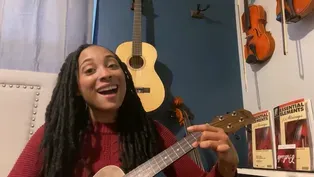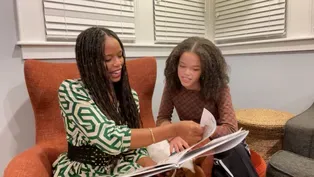
PAPER BRIDGES
Clip: 4/20/2023 | 10m 31sVideo has Audio Description, Closed Captions
Cassondra Easterling and her two children make paper bridges that can hold pennies.
Cassondra Easterling and her children use different approaches to the make paper bridges that can hold pennies. She compares results on a chart.
See all videos with Audio DescriptionADProblems with Closed Captions? Closed Captioning Feedback
Problems with Closed Captions? Closed Captioning Feedback
Let's Learn is a local public television program presented by THIRTEEN PBS

PAPER BRIDGES
Clip: 4/20/2023 | 10m 31sVideo has Audio Description, Closed Captions
Cassondra Easterling and her children use different approaches to the make paper bridges that can hold pennies. She compares results on a chart.
See all videos with Audio DescriptionADProblems with Closed Captions? Closed Captioning Feedback
How to Watch Let's Learn
Let's Learn is available to stream on pbs.org and the free PBS App, available on iPhone, Apple TV, Android TV, Android smartphones, Amazon Fire TV, Amazon Fire Tablet, Roku, Samsung Smart TV, and Vizio.
Providing Support for PBS.org
Learn Moreabout PBS online sponsorship[upbeat folk music] - Hi, friends.
My name is Cassondra, and these are my helpers- - Noel.
- And Emry.
- And we're here today to do a fun science experiment with you.
Today, we are going to be thinking like scientists as we make some bridges.
I wanted to go over the materials that we're going to be using.
So the first thing we're going to use is some paper.
We are using some white paper.
If you have a different kind of paper at home, that would work, too.
We also have something that we are going to use as weights on our bridges when we build them.
We're going to be using some pennies.
But if you'd like to use something else, like some little pieces of candy or maybe some little toys, that would work, too.
The next thing that we have are some books.
We have a stack of books that we're going to use to build up the sides and hold up our bridge.
You could use something else at home if you don't have some books to use, like maybe some cans of vegetables or something like that.
We just need something that we can use to support our bridge.
So we are going to to go ahead and get started with the steps that we are going to use to think like scientists.
So the first thing we're going to do is ask a question.
So the question we're going to be thinking about today is, how can we build the best bridge using our paper and our books to support the most pennies?
In order to do this, we are going to have to come up with a plan.
So Noel and Emry, I want you each to think of a plan.
You're going to get a piece of paper and you're going to need to make a bridge to connect two stacks of books.
So I want you to think of your plan and I want you to tell your plan to our friends at home.
So Emry, do you have a plan that you could share?
- Fold the two sides in and make a bridge.
- Oh, so Emry is going to be folding the two sides in and making a bridge between the stacks of books.
And what about you, Noel?
What is your plan?
- So I want it to be thick, so what I'm gonna do is I'm gonna fold it in half, and then I'm gonna fold it again so it's a little bit of smaller, but it's still very thick so it might hold more pennies.
- Oh, okay.
So Noel's plan is he wants to make a thick bridge.
So he's going to be folding his paper over to make his bridge a little thicker.
All right, so we're going to go ahead and try to make these bridges.
Are you ready?
- Yeah.
- Okay, so this part is going to be our experiment.
That's the next step in us thinking like scientists.
So now I'm going to give Noel a piece of paper and Emry a piece of paper.
So friends at home, let's watch as Noel and Emry make their bridges for our experiment.
Go ahead.
[playful music] Oh, I see.
Noel is making his into a skinny, thick bridge.
And Emry, oh, okay, so her bridge has some sides.
All right, so friends at home, look at this.
We have Noel's bridge.
Look, it's skinny and thick.
And we have Emry's bridge.
It is big and wide and it has some sides.
All right, this is going to be really exciting.
So let's move our books over so that we can put these bridges up.
All right, let's just move this paper out of the way.
All right, let's bring our stacks of books over, and then we'll put the bridges up on the books.
So we've got three stacks of books since we are going to be doing two bridges.
If you were just making one bridge, you could just use two stacks of books.
Okay, so we're going to put Emry's bridge here.
Just make sure that it's held up with our books.
And let's make sure that Noel's bridge fits here.
Yup, looks pretty good.
Okay, friends at home, what do we think?
Whose bridge do you think will hold the most pennies?
Do you think it will be Noel's bridge or Emry's bridge?
Let's find out.
Okay.
Could you count your pennies as you put them on your bridge?
And friends at home, could you help us count the pennies, too?
So as you put your pennies up, can you just count your pennies?
- One.
- One.
- [Noel and Emry] Two, three, four.
- Five.
- Five.
- [Noel and Emry] Six.
- Seven.
- Seven.
- Put your pennies kinda more in the center.
- [Noel and Emry] Eight.
- Nine.
- Nine.
- 10.
- Oh, nine, then mine went down.
- You got nine pennies?
Okay, so this is the next step in...
So we're just gonna scoot Emry's pennies a little bit more into the middle.
Okay.
I think we have to put the pennies in the middle instead of like on the books, okay?
I think that that's one thing.
So let's record.
That's the next step in thinking like a scientist is we have to record our data.
So Noel's bridge, how many did it hold?
Nine?
- Yes.
- Okay, so under his first bridge, we're going to put nine pennies.
Now Emry's, I'm not exactly sure 'cause I think some of the pennies were on the books.
So let's just try this one one more time.
Can you count with me, friends?
- Yeah.
- [All] One, two, three, four.
- Four pennies.
- Okay.
- Okay?
So Emry's bridge held four pennies.
So we're going to put that on the chart.
We're going to record the data from the first bridge that we made.
All right, so now let's think about the next step of our experiment.
So we're going to continue doing our experiment by making another bridge.
So Noel's bridge held nine pennies and Emry's held four.
So let's think about what Noel did that made his bridge hold more pennies.
And how could we change the bridges that we make for the second time?
Okay?
So I want you to think for a second.
How could you each make your bridge hold more pennies this time?
Okay?
- Mm.
- So take a second and think, and then I want you to tell us your new plan for the experiment.
Are you ready?
- Yes.
- Yeah.
- Okay, so Noel, what are you going to do this time?
- So what I'm gonna do is do exactly what I did last time, but just fold the sides in just a little bit, so like kind of like make the pennies be able to, the weight be directly even so it will hold more pennies.
- So is it kinda that you wanna take Emry's idea of doing the sides?
- Yes.
- Okay, so Noel wants to kinda do the same kind of bridge, but he wants to fold in and make sides to hold the pennies on.
Okay, so that's your next idea?
- Yes.
- Okay.
And Emry, how can you make your bridge stronger the second time?
- Well, I wanna do the same thing what I first did and fold the sides more.
- You're gonna fold the sides more this time?
- Yeah.
- Okay, so let's try it and see if our bridges will be stronger the second time.
Okay, so let me just move these books out of the way again so that our friends at home can see you making your new bridges.
All right.
And let's go ahead.
Here you go.
Make your new bridges.
[playful music] Okay, so I see Noel is folding his again.
See Emry's making some more sides.
So are you kinda wanting to just make your sides a little stronger?
- Yeah.
- You think that's gonna be able to support your bridge better?
- Yeah.
- If you make your sides stronger?
- Yeah.
- Okay.
Let's see.
Let's try it, okay?
- Okay.
- All right, so Emry's bridge is...
Her new bridge.
Here's Emry's new bridge.
Okay, and what about you, Noel?
Your new bridge is ready?
- Almost.
- Add those sides folded in?
Okay, so we're gonna give our new bridges a try and we're going to see if we can hold more pennies this time.
So let's move our books back into place.
We have our stacks of books again.
And we'll put the bridges up.
And then remember, this time we're going to make sure that the pennies are in the center of the bridge, not actually on the books, okay?
So go ahead, put your pennies on, and count while you put them on.
- [Noel and Emry] One, two, three.
[penny rattles] - Four.
- Four.
- [Noel and Emry] Five.
- Whoa, Emry's held more this time.
- [Noel and Emry] Six, seven, eight, nine, [Cassondra gasps] 10.
- Whoa, so did Noel's.
- [Noel and Emry] 11, 12, 13.
- Oh, my goodness.
- [Noel and Emry] 14, [penny rattles] 15, 16, 17, 18, 19, 20.
- Oh, my goodness.
Let's stop there, friends.
Wow!
You're getting more than 20 for both of yours!
Wow!
You made your bridge so much stronger the second time!
They both held more than 20 pennies this time!
Good job, Noel and Emry!
Wow, friends at home.
So maybe next time you can try to make a bridge and make some changes when you do your second bridge, like Noel and Emry did, and you could make a bridge that could hold 20 or more pennies.
Wow.
Thank you for joining us, friends.
- [All] Bye!
THE ABC'S OF MUSICAL INSTRUMENTS!
Video has Audio Description, Closed Captions
Arielle Lewis from Education Through Music introduces a variety of musical instruments. (9m 35s)
Video has Audio Description, Closed Captions
Charlie Bardey shows different ways to make 10 when adding two numbers. (8m 15s)
Video has Audio Description, Closed Captions
AVA PLAYS THE STEELPAN DRUM! (49s)
Video has Audio Description, Closed Captions
Maria Begg-Roberson reads HAVOC IN THE HAMMOCK! by Kelly Russell Jaques. (10m 59s)
Video has Audio Description, Closed Captions
Isabel Simmons helps children read and write words with L blends. (11m 54s)
Providing Support for PBS.org
Learn Moreabout PBS online sponsorshipSupport for PBS provided by:
Let's Learn is a local public television program presented by THIRTEEN PBS
















